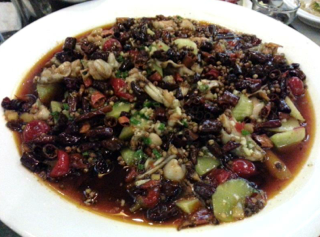For reasons I cannot fathom, consuming insects does not seem to faze the people of Beijing (or China, for that matter). While I can understand the practicality of eat these things, which possess a high nutritional value, I would never actually do it; the idea of crunching down on one, with its many legs…I shudder just thinking about it. The shop was even selling fried scorpions, which makes me wonder whether their venomous stingers were even removed. This particular shop was also selling fried starfish, which one of my friends decided to try. He decided it wasn’t quite worth the purchase.
The snacks of Beijing are not the only weird food to be found. Last night my Foreign Study Program group ate at a restaurant that, like many others in Beijing, served sea cucumbers, birds’ nests (which are the actual nests), and frog, among other delicacies. As you can see below, we ordered a dish of frog legs. It was a little disconcerting, to say the least, to see their little toes and limbs. However, I must add, the meat was quite tender. And as to whether or not it does actually taste like chicken, I am sorry to say (or perhaps not so sorry) that the dish was too spicy for me to taste anything. Perhaps you can try frog yourself one day and tell me. Would you eat it?
Note: All photos taken by me















